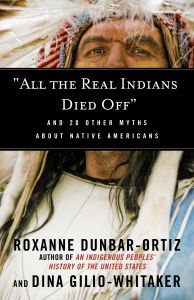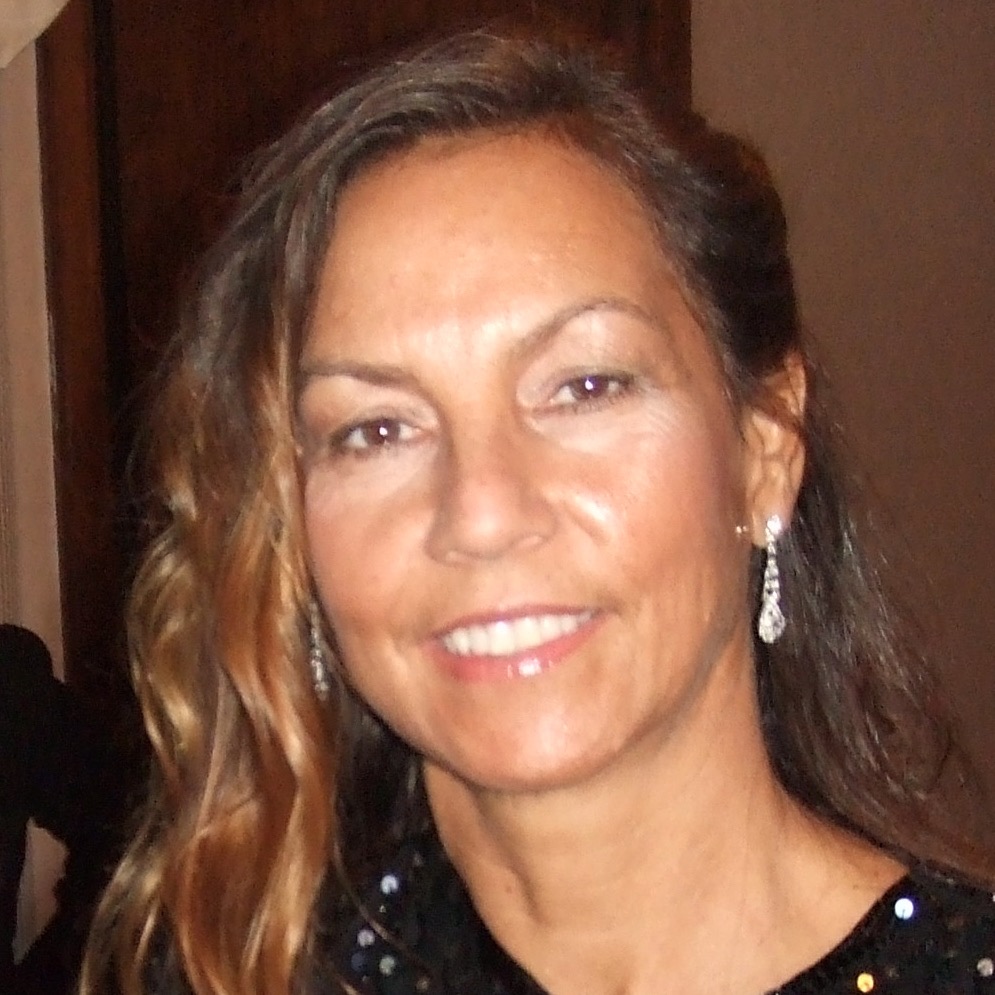
The authors of a book on myths about Native Americans think that the scene, depicted in this painting of the first Thanksgiving by J.L.M. Ferris, doesn't tell the real story. (Image via Getty)
(Editor’s Note: As Thanksgiving approaches in the midst of a strained political time, it’s worth remembering that the roots of the iconic American holiday are also bound up with political infighting and more than a bit of “fake news.” In this excerpt from the newly published book All the Real Indians Died Off: And 20 Other Myths About Native Americans, writers Roxanne Dunbar-Ortiz and Dina Gilio-Whitaker examine what’s real and what’s not about the story of this nation’s origins.)
“Thanksgiving Proves the Indians Welcomed the Pilgrims”
Second only to the Columbus discovery story, the Thanksgiving tale is the United States’ quintessential origin narrative. Like the Columbus myth, the story of Thanksgiving has morphed into an easily digestible narrative that, despite its actual underlying truths, is designed to reinforce a sense of collective patriotic pride. The truths are, however, quite well documented. Their concealment within a simplistic story inevitably depicts a convoluted reality about the Indigenous peoples who played crucial roles in both events, and it presents an exaggerated valorization about the settlers’ roles. The result is a collective amnesia that fuels the perpetuation of Native-American stereotypes, playing out over and over again in the classrooms and textbooks of American schoolchildren, generation after generation. This only masks the complexities of the relationships between settlers and Indians, and thus the founding of the United States.
The Thanksgiving story as we know it is a story of unconditional welcome by the indigenous peoples, a feel-good narrative that rationalizes and justifies the uninvited settlement of a foreign people by painting a picture of an organic friendship. A more accurate telling of the story, however, describes the forming of political alliances built on a mutual need for survival and an Indigenous struggle for power in the vacuum left by a destructive century of foreign settlement.
THE BACKSTORY
The offenses of the Thanksgiving story stem from lack of historical context. For example, it often gives the impression that the Mayflower pilgrims were the first Europeans to settle on the land today known as the United States. But by the time the Mayflower arrived at Plymouth, Massachusetts, in December 1620, Europeans had been traveling to the North American continent, and founding colonies there, for well over a century. Armed with information about the region — made available by the knowledge and mapping of predecessors like Samuel de Champlain — the Eastern Seaboard was dotted with numerous European enclaves and towns. Jamestown, for example, was founded in 1607, while Florida had been populated by the Spanish since the founding of St. Augustine, in 1565. Some colonies, such as the one in Roanoke Virginia, had failed. The Mayflower immigrants, who came to be known as the Pilgrims, were thus, in December 1620, only the latest newcomers to the land, all of which was known at the time to the English as Virginia. Exposure to European diseases had resulted in pandemics among the Natives up and down the coast from Florida to New England throughout the 16th century, exacerbated by the Indian slave trade started by Columbus. Between 1616 and 1619 the region that would soon become Plymouth Colony underwent an unknown epidemic that decimated the Indigenous population by at least one-third to as much as 90 percent — a fact the Pilgrims knew and exploited.
The settlement the Pilgrims called New Plymouth was the ancestral land of the Wampanoag (Pokanoket) people, who called the place Patuxet. Contrary to the popular myth that the Pilgrims arrived to an unoccupied “wilderness,” it had for untold generations been a well-managed landscape, cleared and maintained for cornfields and crops like beans and squash, as well as for game. Also contrary to popular mythology, the Wampanoags, like most eastern Indians, were farmers, not nomads. Up until the epidemic, the Wampanoag nation had been large and powerful, organized into 69 villages in what is today southeastern Massachusetts and eastern Rhode Island. Their exact population is unknown, but estimates range from 24,000 to upward of 100,000. The epidemic decimated their population, however, and destabilized relations with their traditional enemies, the neighboring Narragansett, Mohegan, and Pequot peoples, among others. In 1620 the Wampanoags were in a state of military tension, if not full-scale war with the Narragansetts.
When the Pilgrims arrived at New Plymouth in the depth of winter, food was the first concern. From colonists’ journal entries we know that right after their arrival Native homes and graves were robbed of food and other items. Written accounts describe taking “things” for which they “intended” to pay later. Ever pious and believing in divine predestination, the religious separatists attributed their good fortune to God, “for how else could we have done it without meeting some Indians who might trouble us.” Thus, the Pilgrims’ survival that first winter can be attributed to Indians both alive and dead.
Before the epidemic, Patuxet had been a village with around 2,000 people. Months after their arrival, the colonists had their first serious encounter with an Indian. In March 1621 they came face to face with Samoset, a Wampanoag sachem (leader) of a confederation of about 20 villages. In rudimentary English learned from English fi sherman and trappers, Samoset explained about the plague that had just swept through the area. He also told them about Massasoit, who was considered the head Wampanoag sachem, also known as a sagamore. Within a few days, Massasoit appeared at the Plymouth colony accompanied by Tisquantum (Squanto), eager to form an alliance with the colonists in light of the shifting balance of power in the Indigenous world due to the plague. A formal treaty was immediately negotiated, outlining relationships of peace and mutual protection. Massasoit sent Squanto as a liaison between the Native confederation and the colonists, and Squanto taught them Native planting techniques that ensured the bountiful harvest they would enjoy in the fall. Squanto had been kidnapped as a child, sold into slavery, and sent to England, where he learned how to speak English. Having escaped under extraordinary circumstances, he found passage back to Patuxet in 1619 only to find himself the sole male survivor of his village.
THE FIRST THANKSGIVING
The facts about the first Thanksgiving come from two primary written sources, Edward Winslow’s Mourt’s Relation and William Bradford’s Of Plimouth Plantation. Neither of the accounts are detailed enough to surmise the familiar tale of Pilgrims hosting a feast to thank the Indians for their help, certainly not enough to imagine Englishmen teaching the Indians about thanksgiving as we are sometimes led to believe. The English had an ancient custom of harvest festivals that had been secular, not religious affairs. Spiritual ceremonials of gratitude had always been central cultural attributes among indigenous peoples who believed in relationships of reciprocity, so the concept of thanksgiving was not new to either group.
Only Winslow’s account, written several weeks after the event, mentions the Indians’ participation. He wrote:
Our harvest being gotten in, our governor sent four men on
fowling, that so we might after a special manner rejoice together,
after we had gathered the fruits of our labors; they four
in one day killed as much fowl, as with a little help beside,
served the Company almost a week, at which time amongst
other Recreations, we exercised our Arms, many of the Indians coming amongst us, and amongst the rest their greatest king
Massasoit, with some 90 men, whom for three days we entertained
and feasted, and they went out and killed five Deer,
which they brought to the Plantation and bestowed on our
Governor, and upon the Captain and others. And although it be
not always so plentiful, as it was at this time with us, yet by the
goodness of God, we are so far from want, that we often wish
you partakers of our plenty.
Not all historians agree as to what actually happened that day. It is clear that the colonists decided to have a harvest celebration (note that nowhere is the word “thanksgiving” used).
As can be deduced from the account, one widely espoused interpretation holds that the Indians were not initially invited to share in the celebration. They came when they heard in the distance the discharge of guns, fired in the exuberance of the festivities. Wondering if there was trouble, the Wampanoags entered the English village with around 90 men. It was only after arriving well-intentioned but uninvited that an invitation to stay was extended. Since there wasn’t enough food to go around, the Indians went out and caught some deer, which they ceremonially presented to the English.
Throughout Mourt’s Relation (written over a period of one year from November 1620 to November of 1621) references are made to the affection and camaraderie between the Plymouth colonists and Massasoit and Squanto, but the tenuous peace was to be short-lived. Acting independently, Squanto had developed rogue tendencies in an apparent power struggle with Massasoit. He increasingly undermined the authority of Massasoit and other sachems, eventually driving a fatal wedge between himself and Massasoit and straining the relations between Massasoit and the colony. By the spring of 1622, Massasoit had ended trade between the confederation and the English, and the colony held on desperately to their relationship with Squanto. In October Squanto died under mysterious conditions. Nataniel Philbrick wrote that although it is difficult to document, he may have been poisoned in an assassination plot masterminded by Massasoit.
Within a few months Massasoit had reestablished diplomatic relations with the colony. He appointed Hobamok as his intermediary, and an uneasy alliance was maintained with the colony until Massasoit’s death around 1661. He would be succeeded by his son Wamsutta, and by 1662 his second son, Metacom, known to the English as King Philip, was in charge. Because of the unrelenting pressure of the English demands for land, relations would deteriorate so severely between the English and the Wampanoags that by 1675, war broke out. Called King Philip’s War, it has come to be seen as the bloodiest, most violent conflict ever fought on American soil. Thus, in light of the larger history, the simplistic idea that Thanksgiving proves that the Indians welcomed the Pilgrims can be more accurately seen as a temporary chapter characterized by maximized political self-interest on all sides.
Excerpted from All the Real Indians Died Off+: And 20 Other Myths About Native Americans by Roxanne Dunbar-Ortiz and Dina Gilio-Whitaker (Beacon Press, 2016). Reprinted with Permission from Beacon Press.






